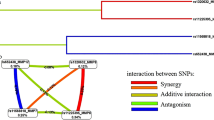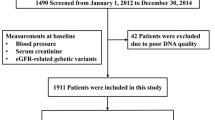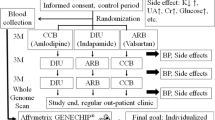Abstract
The adrenomedullin receptor is a complex molecule that comprises the calcitonin-receptor-like receptor (CRLR) and the receptor-activity-modifying protein (RAMP). RAMP1 is a vasodilation factor, and RAMP1-deficient mice (RAMP1(−/−)) exhibit inflammatory responses with a significant transient increase in serum calcitonin-gene-related peptide levels and proinflammatory cytokines when compared with RAMP1(+/+) mice. The purpose of the present study was to investigate the relationships between essential hypertension (EH) and RAMP1 gene single-nucleotide polymorphisms (SNPs) or haplotypes in a Japanese population via a case–control study. Based on a database search of the National Center of Biotechnology Information website and the HapMap project, we chose six RAMP1 gene SNPs and performed an association study involving 263 patients with EH and 267 age-matched normotensive (NT) subjects. There was no significant difference between the EH and NT groups with regard to overall distribution of genotypes or SNP alleles. However, the haplotype-based case–control analysis revealed that there was a significant difference between the EH and NT groups with regard to overall distribution of the allele combinations at three SNPs—rs3754701–rs3769048–rs10199956—(P=0.002). The T-A-T haplotype was significantly more common in the EH group (10.3%) than in the NT control group (6.1%) (P=0.047). These results suggested that this T-A-T RAMP1 gene haplotype might have utility as a genetic marker for EH and that the RAMP1 gene or a neighbouring gene may be associated with increased susceptibility to EH.
This is a preview of subscription content, access via your institution
Access options
Subscribe to this journal
Receive 12 digital issues and online access to articles
$119.00 per year
only $9.92 per issue
Buy this article
- Purchase on Springer Link
- Instant access to full article PDF
Prices may be subject to local taxes which are calculated during checkout


Similar content being viewed by others
References
Steiner S, Muff R, Gujer R, Fischer JA, Born W . The transmembrane domain of receptor-activity-modifying protein 1 is essential for the functional expression of a calcitonin gene-related peptide receptor. Biochemistry 2002; 41: 11398–11404.
Watkins HA, Walker CS, Ly KN, Bailey RJ, Barwell J, Poyner DR et al. Receptor activity-modifying protein-dependent effects of mutations in the calcitonin receptor-like receptor: implications for adrenomedullin and calcitonin gene-related peptide pharmacology. Br J Pharmacol 2014; 171: 772–788.
Hay DL, Walker CS, Gingell JJ, Ladds G, Reynolds CA, Poyner DR . Receptor activity-modifying proteins; multifunctional G protein-coupled receptor accessory proteins. Biochem Soc Trans 2016; 44: 568–573.
Edvinsson L, Ahnstedt H, Larsen R, Sheykhzade M . Differential localization and characterization of functional calcitonin gene-related peptide receptors in human subcutaneous arteries. Acta Physiol (Oxf) 2014; 210: 811–822.
Duboz P, Boëtsch G, Gueye L, Macia E . Hypertension prevalence, awareness, treatment and control in Dakar (Senegal). J Hum Hypertens 2014; 28: 489–493.
Booth HP, Prevost AT, Gulliford MC . Severity of obesity and management of hypertension, hypercholesterolaemia and smoking in primary care: population-based cohort study. J Hum Hypertens 2016; 30: 40–45.
Wang Z, Nakayama T, Sato N, Izumi Y, Kasamaki Y, Ohta M et al. The purinergic receptor P2Y, G-protein coupled, 2 (P2RY2) gene associated with essential hypertension in Japanese men. J Hum Hypertens 2010; 24: 327–335.
Pan S, Nakayama T, Sato N, Izumi Y, Soma M, Aoi N et al. A haplotype of the GOSR2 gene is associated with myocardial infarction in Japanese men. Genet Test Mol Biomarkers 2013; 17: 481–488.
Nakayama T, Soma M, Rahmutula D, Ozawa Y, Kanmatsuse K . Isolation of the 5'- flanking region of genes by thermal asymmetric interlaced polymerase chain reaction. Med Sci Monit 2001; 7: 345–349.
Sano M, Kuroi N, Nakayama T, Sato N, Izumi Y, Soma M et al. The association study of calcitonin-receptor-like receptor gene in essential hypertension. Am J Hypertens 2005; 18: 403–408.
Maximum likelihood from incomplete data via the EM algorithm. J R Stat Soc; Series B (Methodological) 1977; 39: 1–38.
Excoffier L, Slatkin M . Maximum-kikekihood estimation of molecular haplotype frequencies in a diploid population. Mol Biol Evol 1995; 12: 921–927.
Shimodaira M, Nakayama T, Sato I, Sato N, Izawa N, Mizutani Y et al. Glucocorticoid synthesis related-genes: HSD11B1 and HSD11B2 in hypertensive disorders in pregnancy. Gynecol Endocrinol 2013; 29: 657–661.
Nakazato T, Nakayama T, Naganuma T, Sato N, Fu Z, Wang Z et al. Haplotype-based case-control study of receptor (calcitonin) activity modifying protein-1 gene in cerebral infarction. J Hum Hypertens 2010; 24: 351–358.
Wan D, Hou L, Zhang X, Han X, Chen M, Tang W et al. DNA methylation of RAMP1 gene in migraine: an exploratory analysis. J Headache Pain 2015; 16: 90.
Cargnin S, Pautasso C, Viana M, Sances G, Mittino D, Cantello R et al. Association of RAMP1 rs7590387 with the risk of migraine transformation into medication overuse headache. Headache 2015; 55: 658–668.
Morris RW, Kaplan NL . On the advantage of haplotype analysis in the presence of multiple disease susceptibility alleles. Genet Epidemiol 2002; 23: 221–233.
Sato N, Nakayama T, Mizutani Y, Yuzawa M . Novel mutations of ABCC6 gene in Japanese patients with angioid streaks. Biochem Biophy Res Commun 2009; 380: 548–553.
Naganuma T, Nakayama T, Sato N, Fu Z, Soma M, Yamaguchi M et al. Haplotype-based case-control study on human apurinic/apyrimidinic endonuclease 1/redox effector factor-1 gene and essential hypertension. Am J Hypertens 2010; 23: 186–191.
Acknowledgements
We thank Ms K Sugama for her technical assistance. This work was supported by grants from Toray Co, Ltd, and from the Ministry of Education, Culture, Sports, Science and Technology of Japan (16K089780002). This work was also supported by a grant from the Health Sciences Research Institute, Inc, Yokohama, Japan to the Division of Companion Diagnostics, Department of Pathology of Microbiology, Nihon University School of Medicine, Tokyo, Japan.
Author information
Authors and Affiliations
Corresponding author
Ethics declarations
Competing interests
The authors declare no conflict of interest.
Rights and permissions
About this article
Cite this article
Nakayama, T., Nakazato, T., Naruse, H. et al. Haplotype-based, case–control study of the receptor (calcitonin) activity-modifying protein (RAMP) 1 gene in essential hypertension. J Hum Hypertens 31, 361–365 (2017). https://doi.org/10.1038/jhh.2016.96
Received:
Revised:
Accepted:
Published:
Issue Date:
DOI: https://doi.org/10.1038/jhh.2016.96



